#google data visualisation
Explore tagged Tumblr posts
Text
Shiwali Mishra: Mastering Google Data Visualization for Digital Success

Discover Shiwali Ratan Mishra, a leading expert in Google data visualization and analysis. With a unique blend of technical prowess and strategic insight, Shiwali transforms complex data into compelling narratives, driving business success through enhanced data understanding. Her expertise in data visualization and analysis empowers clients to make informed decisions, leveraging her deep knowledge and innovative approach. Shiwali’s commitment to excellence and her passion for data-driven solutions make her a standout professional in the field, offering impactful results and clear, actionable insights.
0 notes
Text
100+ Looker Studio Templates of 2024
Looker Studio experts with their expertise crafted 100+ Looker Studio Templates with various data connectors and categories like PPC, Social media, Web analytics, SEO and much more are available here with us. Two Minute Reports a Marketing Analytics product helps users analyze and visualize data using Looker Studio for all their connectors like Facebook Ads, Google Analytics, Search Console, and much more.

NOTE: You need to have a free trial or basic plan of Two Minute Reports for the below step. To use these Templates click here -> choose your Template -> Click on use Template, add your data source and query -> start using your Template. To use it Free: Click here -> choose your template -> click edit -> make a copy -> and use your own data source from Google Sheets or 3 rd party tools.
#templates#looker studio#google data studio#looker studio templates#data visualization#data visualisation
0 notes
Text
For everyone who asked: a dialogue parser for BG3 alongside with the parsed dialogue for the newest patch. The parser is not mine, but its creator a) is amazing, b) wished to stay anonymous, and c) uploaded the parser to github - any future versions will be uploaded there first!
UPD: The parser was updated!! Now all the lines are parsed, AND there are new features like audio and dialogue tree visualisation. See below!
Patch 7 dialogue is uploaded!
If you don't want to touch the parser and just want the dialogues, make sure to download the whole "BG3 ... (1.6)" folder and keep the "styles" folder within: it is needed for the html files functionality (hide/show certain types of information as per the menu at the top, jumps when you click on [jump], color for better readability, etc). See the image below for what it should look like. The formatting was borrowed from TORcommunity with their blessing.
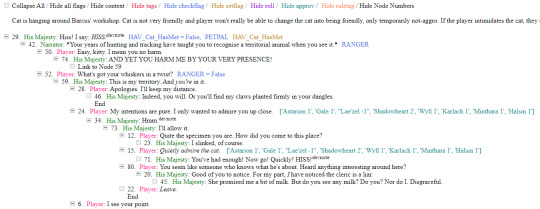
If you want to run the parser yourself instead of downloading my parsed files, it's easy:
run bg3dialogreader.exe, OPEN any .pak file inside of your game's '\steamapps\common\Baldurs Gate 3\Data' folder,
select your language
press ‘LOAD’, it'll create a database file with all the tags, flags, etc.
Once that is done, press ‘EXPORT all dialogs to html’, and give it a minute or two to finish.
Find the parser dialogue in ‘Dialogs’ folder. If you move the folder elsewhere, move the ‘styles’ folder as well! It contains the styles you need for the color coding and functionality to keep working!
New features:
Once you've created the database (after step three above), you can also preview the dialogue trees inside of the parser and extract only what you need:

You can also listen to the correspinding audio files by clicking the line in the right window. But to do that, as the parser tells you, you need to download and put the filed from vgmstream-win64.zip inside of the parser's main folder (restart the parser after).
You can CONVERT the bg3 dialogue to the format that the Divinity Original Sin 2's Editor understands. That way, you can view the dialogues as trees! Unlike the html files, the trees don't show ALL the relevant information, but it's much easier to orient yourself in.


To get that, you DO need to have bought and installed Larian's previous game, Divinity Original Sin 2. It comes with a tool called 'The Divinity Engine 2'. Here you can read about how to unstall and lauch it. Once you have it, you need to load/create a project. We're trying to get to the point where the tool allows you to open the Dialog Editor. Then you can Open any bg3 dialogue file you want. And in case you want it, here's an in-depth Dialog Editor tutorial. But if you simply want to know how to open the Editor, here's the gist:
Update: In order to see the names of the speakers (up to ten), you can put the _merged.lsf file inside of the "\Divinity Original Sin 2\DefEd\Data\Public\[your project's name here]\RootTemplates\_merged.lsf" file path.
Feel free to ask if you have any questions! Please let me know if you modify the parser, I'd be curious to know what you added, and will possibly add it to the google drive.
2K notes
·
View notes
Note
any tips or stuff youve learned along the way on making a headworld "series bible" of sorts?
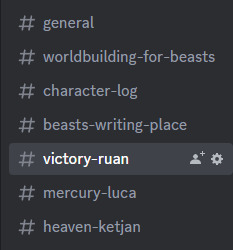
discord categories & channels (ft. the old working title of Where Hate Rules because i forgot to change it). i have a discord server with just me in it where I have a channel category for each writing project.
scroll down for a spreadsheet data blast
General - image dump, place to throw in new ideas so I don't forget them, plot points, etc
Worldbuilding - this is for stuff that's set in stone, not vague concepts. maps, diagrams, etc (i have a lot of diesel engine block diagrams and celestial illustrations in there as well as every holy beast)
Character log - literally just a list of characters. put in every character in the same format (i.e Name, Age, Profession, Physical Description, Hometown)
Writing Place - for prose. I write in libreoffice but when I'm out of the house on mobile or just doing test paragraphs they go here because I'd rather kill myself than use google docs ever. Each new piece of writing has an easily-searched title.
After this I have a channel for every main character. In here I put art relating to them, backstory, motivations, any random thoughts I have about them and so on. You don't wanna see how many of these I have for my Inver channel category lmaoo.
No, there are better ways to visualise Inver's absolutely massive series bible!
Discord is obviously only useful if you're online and I don't like storing so much shit in the cloud. And what if I need rows AND columns?
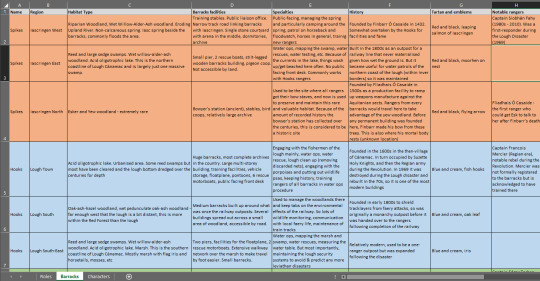
man i love spreadsheets. zoom in and get a load of that sweet sweet fossit guide.
this is me kissing microsoft excel with tongue to produce a datasheet about the modern-day ranger barracks in Inver (year 2017, Pascal's time) but any spreadsheet program will do. Even (gag) google sheets. I made this because in the modern era, rangers are ecologists! They participate in land management as well as faery relations.
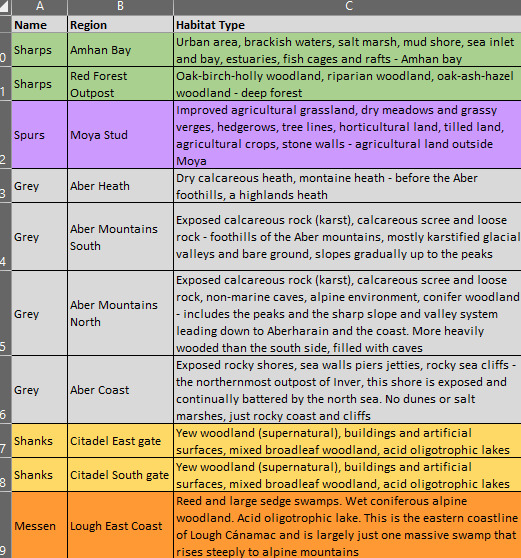
Okay so. First thing you want to do is freeze the top row so that it remains in place when you scroll. Then populate the boxes. Here, each ranger organisation (column 1) is given its own bg colour based on its main tartan colour so visual reference is easy. The characters tab is similar - frozen top row with basic categories, then a colour-coded list of rangers.
I have one of these for 1800s Inver as well! Luckily I only had to do the habitats once since they didn't change much over the years.
Hopefully that helps?? Basically: if you're lazy and need to generate ideas and data on the go, pick discord. If you want to be more specific, make a spreadsheet or 6.
169 notes
·
View notes
Text


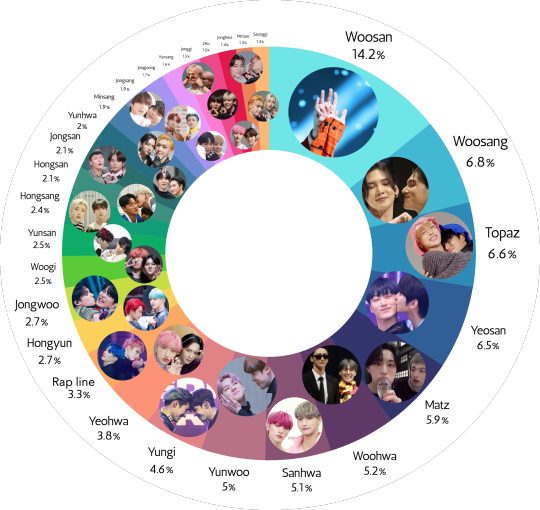
I did some spreadsheeting out of curiosity! :D The topic of this is how many files i have of each member, as well as the ships.
I'm just posting this bc i think it's inch resting and bc i thought osmeone else might agree :)
The three pics above:
1: How many files are in each of the different folders i have for each memebr, visualised. The green category, "ships", is the result of how many times each member appears in the folders I have for each ship/pairing.
2: The spreadsheet numbers of picture 1, plus the totals for the whole group.
3: How many files are in each ship/pairing folder. And here are the spreadsheet data for this:
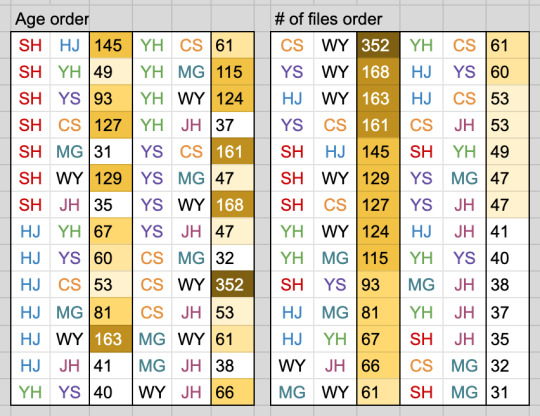
And a simple visual of how many files I have of each member, total:
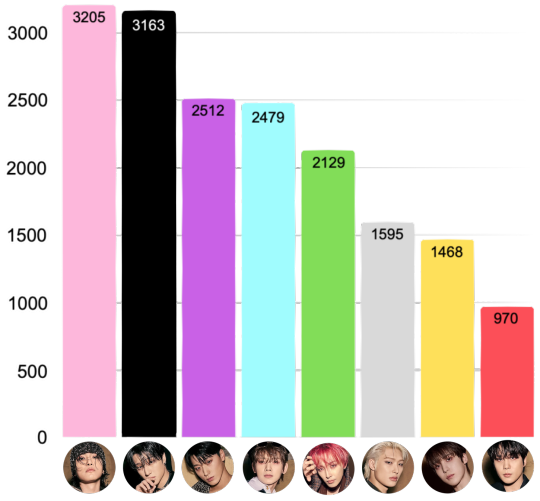
None of the above numbers include the files i have of all - or more than two - of the members. I found those numbers too though just bc i am curious,
All · potoshoot: 219 All · casual: 298 Gifs: 26 Video: 36 Two or more members, but not the whole team: 300
Google docs very conveniently tells me how much data i have.
Individual member folders, all combined: 10.69 GB (nice) Group and pairing folders, all combined: 8.84 GB
13 notes
·
View notes
Note
Thank you for all your help with this! your solution for the project totals worked perfectly :D
As for the difficulty deleting projects, thanks again for looking into it. I’m using Google sheets, and when I delete a project - any of them - the top stats sheet starts looking like this:

(The clipped words image was already like that) The chart sheet otherwise deleted the data just fine, but looks like this:

And totals like this:

The 2024 word count in yearly comps has that same REF image instead of a number, and the chart instead says ‘Add a series to start visualising your data’. In totals and comps data the information for the deleted project also shows the REF message, unless I manually delete that column as well (idk if that’s an issue but best be thorough). Daily graph and chart remove the data fine, and if I delete a project that has its own sheet it’s replaced with the add a series message, which I assume is supposed to happen. I haven’t noticed and other adverse affects.
(Seriously, thank you for helping me so much. You’re amazing, and even if you don’t find/know a work around for this you’ve been a huge help!)
Ah, okay, I seeeeeee. So, anywhere you see that #REF! message, it's because it's trying to reference information that's not there any more. In this case, you did the right thing by deleting the project column from the Totals sheet! If you delete a project column in the Daily sheet, you also need to delete its corresponding columns in the Comps. Data and Totals sheets. This is because both of those sheets pulled information from the deleted project column in the Daily sheet, and they'll still be trying to fulfil a formula that no longer has the necessary information to work.
Once those columns are deleted, follow the instructions for deleting a series from a chart on page 7 of the instructions booklet, and delete the project's series from the Totals chart.
Something you could do in the future, instead of deleting project columns from the Daily sheet, is to hide them (right-click on the letter above the column and choose "hide column" from the drop-down menu). Choosing this method means that a) you don't need to delete any project columns elsewhere, and b) "adding" more columns, should you ever need them, becomes a matter of unhiding the column. The only change you'll need to make then is deleting the project series from the Totals chart, as explained in previous paragraph.
(And yes, deleting a project column will affect its corresponding sheet, if it has one. Pages 23–24 of the instructions explain how to make a new project-specific sheet, and you can follow those same instructions to link the sheet to a different project column, if you want to. Otherwise, feel free to hide/delete the sheet.)
However. I noticed that for some reason, removing any data from the totals chart converts the previously-invisible line for the totals into a stacked column instead. To fix that, right-click on the chart and select "Chart style" to open the Chart editor window. Then, under the "customise" tab, scroll down and click on the option that says "series". Pick "Totals" from the drop-down menu of series, and change where it says "column" to "line" and set the line opacity to 0 (Shown in the left image).
Below this section, there is a list of three tick-boxes labelled Error bars, Data labels and Trend line. Click the box for Data labels, and make sure the text colour is set to black. You'll then get a number for total words written that month appearing above the stacked columns. (Shown in right image)

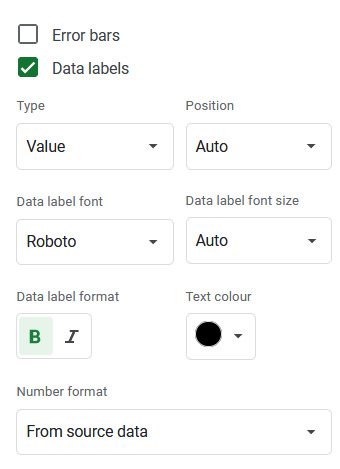
Fixing the Top Stats sheet:
In the case of the current streak counter, the issue is in two places: with the formula that counts the current streak:

and the formula that decides whether to say "to date" or "as of yesterday":

I've underlined the bits you'll need to change. You can find more details on how to do this and how it works on pages 9–10 (Top Sheets explanation) and 18 (how the streak counter works) of the instructions document.
also. if those squashed "words" textboxes are annoying you (they would drive me nuts lol), I think the problem is that the text box isn't set to resize itself with the text (even though I thought i did that...). Try clicking on the box, then on the little three dots symbol and choose "Edit" from the menu that appears. When the Drawing window opens, select that icon next to the box (circled), and choose "Resize shape to fit text".
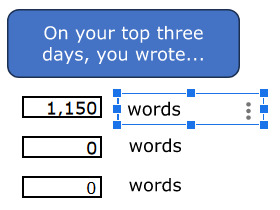

8 notes
·
View notes
Text
Top Trends Shaping Classrooms Latest trends in educational technology for personalized learning
latest trends in educational technology for personalized learning is remodeling the panorama of getting to know, shaping how college students and educators engage with content material, and altering the very nature of the instructional enjoy. As we circulate in addition into the twenty first century, numerous tendencies are rising that promise to decorate academic results, customise getting to know, and put together students for a hastily evolving world. This article delves into the current developments in academic technology, examining their implications and potential effect on the future of training.
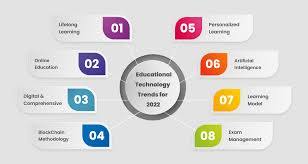
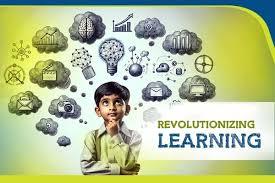
Artificial Intelligence (AI) and Machine Learning
Impact of artificial intelligence on classroom learning experiences and machine gaining knowledge of are revolutionizing schooling by way of enabling more customized and adaptive studying reports. AI-powered systems can analyze pupil performance records to tailor educational content to man or woman wishes. For example, AI can perceive a student’s strengths and weaknesses, supplying customized sporting events and resources to address particular gaps in expertise.
Key Applications
Adaptive Learning Systems
Platforms like DreamBox and Knewton adjust the problem and kind of content based on real-time evaluation of scholar interactions.
Automated Grading
AI can grade assignments and provide instantaneous comments, reducing the administrative burden on educators and letting them recognition greater on interactive coaching.
Virtual Reality (VR) and Augmented Reality (AR)
Virtual Reality (VR) and Augmented Reality (AR) are developing immersive gaining knowledge of environments that could decorate engagement and information. These technologies offer college students the opportunity to discover and engage with content in approaches that conventional strategies can not.
Key Applications
Virtual Field Trips
VR allows college students to go to historic websites, outer space, or maybe microscopic environments with out leaving the classroom. For instance, Google Expeditions gives virtual area trips to numerous global landmarks.
Interactive Simulations
: AR packages like JigSpace permit students to visualise complex ideas, such as the workings of the human frame or mechanical structures, via interactive 3-D fashions.
Gamification
Gamification incorporates recreation design elements into instructional settings to make gaining knowledge of extra enticing and motivating. By integrating factors, badges, leaderboards, and other recreation-like functions, educators can beautify scholar motivation and participation.
Educational Games
Platforms like Kahoot! And Quizizz use game mechanics to make quizzes and evaluation periods extra interactive and competitive.
Game-Based Learning Environments
Tools like Classcraft include function-gambling sport elements to encourage nice behavior and collaboration among students.
Learning Analytics
Learning analytics involves the collection and evaluation of data related to pupil getting to know methods and results. By leveraging data, educators can benefit insights into student overall performance and make knowledgeable selections to enhance teaching strategies and gaining knowledge of environments.
Performance Tracking
Learning management systems (LMS) like Canvas and Blackboard offer analytics dashboards that assist educators monitor student progress and identify trends.
Predictive Analytics
Tools such as Brightspace’s Insights use ancient statistics to expect student performance and perceive those at risk of falling at the back of.
Cloud-Based Learning Platforms
Cloud-primarily based mastering systems provide flexible and scalable answers for handing over educational content material and dealing with classroom sports. These systems facilitate collaboration, useful resource sharing, and get right of entry to to instructional materials from anywhere with a web connection.
Collaborative Tools
Google Classroom and Microsoft Teams for Education provide gear for document sharing, institution work, and communication amongst college students and teachers.
Resource Access: Platforms like Edmodo and Schoology enable college students to access route materials, submit assignments, and interact with friends and instructors on-line.
EdTech for Special Education
Technology is more and more getting used to support students with unique wishes, imparting gear and assets tailored to numerous mastering requirements. Assistive technologies and adaptive mastering equipment are assisting to create more inclusive academic environments.
Text-to-Speech and Speech-to-Text Tools
Tools like Kurzweil 3000 and Dragon NaturallySpeaking assist college students with analyzing and writing problems.
Customized Learning Environments:
Software like ModMath helps college students with dysgraphia by using providing a digital platform for fixing math troubles.
Blockchain for Education
Blockchain generation, recognised more often than not for its use in cryptocurrencies, is beginning to make an impact in education through its ability to securely and transparently manage instructional facts and credentials.
Digital Diplomas and Certificates
Platforms like Learning Machine and the MIT Media Lab are using blockchain to issue and verify virtual diplomas and certificates, lowering fraud and simplifying the credential verification method.
Decentralized Learning Records
: Blockchain can create steady, immutable statistics of scholar achievements and gaining knowledge of pathways, supplying a complete and verifiable educational history.
Personalized Learning
Personalized learning leverages technology to tailor academic stories to the specific needs and options of every student. This technique aims to enhance learning by using accommodating person getting to know styles, paces, and hobbies.
Customized Learning Paths
Platforms like Khan Academy and Coursera provide publications that adapt to the learner’s pace and provide recommendations based totally on progress and hobbies.
Learning Profiles
Tools inclusive of SMART Learning Suite allow teachers to create and track personalized getting to know profiles for every student, facilitating targeted coaching and comments.
Internet of Things (IoT) in Education
The Internet of Things (IoT) connects various devices and sensors to the net, enabling clever lecture rooms wherein bodily items can have interaction with digital structures. This technology has the ability to enhance each coaching and mastering stories.
Smart Classrooms
IoT gadgets like clever whiteboards and related sensors can music classroom situations, along with temperature and lights, and modify them to optimize gaining knowledge of environments.
Interactive Learning Tools
IoT-enabled devices, including linked robots and programmable sensors, offer hands-on learning reviews in subjects like robotics and science.
Mobile Learning
Mobile getting to know, or m-studying, utilizes cellular devices like smartphones and capsules to facilitate getting to know out of doors traditional classroom settings. This fashion helps anytime, everywhere access to educational assets.
Educational Apps
Apps such as Duolingo for language getting to know and Photomath for solving math troubles offer on-the-go gaining knowledge of possibilities.
Flexible Learning Resources
Mobile structures allow students to get right of entry to path materials, participate in discussions, and entire assignments from their devices.
#latest trends in educational technology for personalized learning#Impact of artificial intelligence on classroom learning experiences
2 notes
·
View notes
Text
Rant warning
Topic media literacy, capitalism , this infographic/article:

For context, Google news has figured out that I really like to click on articles with good data visualisations. I just love a meaningful representation of the distribution of anything on a national or global scale, because it's so hard for us to wrap our heads around things at that scale. The visual capitalist puts out tons of these. And a lot of them are good.
But, the challenge here is not only reading the data, to gain a better understanding of what's going on in the world, but figuring out why someone made the graphic in the first place, and then trying to remove their bias to get at the actual valuable information the data gives us.
In this case the initial grab at your attention remotes on the term "family businesses" which we tend to associate with "small business", which everyone agrees is a very good thing. The one jerk after that is "India has the most family businesses, and the US (relevant to me) is doing better than I would have guessed. Then you read the words and numbers and realize that these are some of the biggest and worst companies in the world.
Looking into the article, the author even acknowledged this. They don't say the companies are bad or point out other implications, beyond their economic influence. The articles point is pretty light politically, but valuable for like an investor or someone of that sort.
But, I think it's important to note the impact of their approach. They know that 99% of people's interactions will stop at the first step. "small business is strong, and India is winning at it, but, the US is doing okay". The only people who will go further are the ones who noticed the distribution in wording. We can then read the article and find that out concerns are acknowledged. But the damage is done.
Now for the useful data. The article highlights the amount of wealth and impact that these families have. It presents that as useful investing data. But, I'm person who supports small business, and the value of the average citizen (read socialist). To me it's more useful in understanding where the real wealth hoarding, population subjugating capitalists are. In my opinion, massive family owned businesses, are really the heart of modern oligarchy. You can disagree. But, the article points out that they control more than a quarter of private wealth globally, and far more in the fastest developing markets in the world.
The data in this article is especially valuable to me because family owned businesses are a bit stealthy on the global stage. We get lists and headlines about the richest INDIVIDUALS in the world. But, a large family that's owned one of the largest companies in their country for generations can have far more wealth than the richest individual in that country, without any given family member it showing up on Forbes. What's more, they can have horrendous business practices without their names showing up in headlines, because the company name is more succinct.
This article highlights an Indian family who owns more than 5% of their countries GDP. It also mentions the amount of Us GDP that's owned by family businesses, before giving a short list of the largest ones, without further detail. I could do some quick googling and math to drive my personal views home. But that's not actually the point of this post.
The point is that every article is written with a purpose. Every piece of data is valuable. We all need to learn to look at data from whatever source is presented to us, find the intended purpose of it, even if it's presented as unbiased, peel back the bias, and take the real information. Then, we can start to see the real picture and form our own opinions!
TLDNR: This graphic wants you to think small business is doing well. But, the data inside really says that a few rich people control everything.
#walmarts annual revenue is almost 3x elon's net worth#media literacy#data#data analysis#learn to read#rants#hyperfixation#socialism#capitalism#reading comprehension#read Marx
3 notes
·
View notes
Text
Today my prof complimented my data analysis and my friend from class complimented my graphs and charts and said my article flowed well. The whole time I was making all those graphics, I was convinced that I should have been doing something else, that I was in an ADHD rabbit hole just picking away at excel and google maps because I'm obsessive, and telling myself "I'm just not cut out for journalism" at every turn. Fuck maybe I'm not shit at journalism. Maybe it's just me being dogshit at time management for ADHD reasons. I'm actually a decent writer I think. & I'm good with making those visualisations. And I have the potential to become the ultimate Excel Wizard
#personal#four and a half years into my journalism degree... i better be decent at writing hahaha#i should get that girl's phone number since she doesn't have social media?? we're similar people we should be friends outside of class
3 notes
·
View notes
Text
Advanced Digital Marketing Certifications Course
In today’s rapidly evolving digital world, staying ahead in marketing means mastering more than just the basics. Businesses are investing heavily in digital strategies, and employers are looking for marketers who bring deep expertise, not just theoretical knowledge.
If you already understand the fundamentals of SEO, social media, and content marketing—but want to take your career to the next level—an Advanced Digital Marketing Certification Course could be your game-changer.
Here’s everything you need to know before enrolling, including what to expect, who it’s for, and the best certifications to consider in 2025.
Benefits of Advanced Digital Marketing Certifications Course
There are several advantages to spending time and money on advanced digital marketing certifications that can boost your career:
Specialization & Expertise: General knowledge is good, but advanced certifications allow you to become a recognized expert in a niche area like complex PPC strategies, advanced SEO analytics, or enterprise-level content marketing. This specialization makes you invaluable.
Enhanced Career Opportunities: Employers actively seek candidates with verified advanced skills. Certifications from reputable bodies can open doors to senior roles, consulting opportunities, and significantly higher salaries, as you can directly demonstrate your value.
Credibility: An advanced certification acts as a powerful third-party endorsement of your capabilities. It signals to employers and clients that you possess a high level of proficiency and adhere to industry best practices.
Structured Learning & Practical Application: These courses often provide structured learning paths, real-world case studies, and hands-on exercises that allow you to apply complex concepts and develop practical skills beyond theoretical understanding.
Networking Opportunities: Many advanced programs connect you with a community of like-minded professionals, instructors, and industry leaders, fostering valuable networking opportunities that can lead to mentorship and future collaborations.
Top Advanced Digital Marketing Certifications & Courses
1 ) Paid Media (PPC / META Ads) Mastery
For those focused on driving immediate results through paid advertising.
Google Ads Certifications (Advanced Specializations): Beyond the basics, Google Skillshop offers advanced certifications in Search, Display, Video, Shopping, and App Ads, requiring a deep understanding of complex campaign structures, bidding strategies, and optimization techniques. Look for those that focus on Performance Max and AI integration.
Meta Ads Certifications (Advanced Levels): These certifications validate expertise in advanced advertising strategies across Facebook, Instagram, and Messenger. Examples include "Media Planning Professional" and "Media Buying Professional," which cover sophisticated targeting, campaign optimization, and performance analysis.
2 ) Search Engine Optimization (SEO) Deep Dive
For optimizing organic visibility and driving long-term traffic growth.
SEMrush SEO Certifications: Using their vast data and tools, SEMrush offers a number of advanced courses on its site (such as the SEO Toolkit Exam and Advanced SEO Strategy with Brian Dean) that educate in-depth organic search optimisation.
Advanced SEO Certifications: Advanced SEO subjects like technical SEO audits, advanced keyword planning, link building techniques, and competitive analysis are covered in-depth in Moz's extensive courses and certifications.
3 ) Analytics & Data Science in Marketing
For those who love numbers and derive actionable insights from data.
Google Analytics Individual Qualification (GA4): Explore advanced GA4 implementation, unique data gathering, e-commerce monitoring, and using Google Looker Studio (previously Data Studio) for sophisticated reporting and visualisation in addition to the fundamental GA4.
Adobe Certified Professional - Analytics: This certification for Adobe Analytics, a potent tool for intricate data analysis and customer journey mapping, attests to proficiency with enterprise-level Adobe Experience Cloud products.
Google Data Analytics Professional Certificate (Coursera): This Google certificate provides fundamental data analysis abilities, such as SQL, R, Python, and Tableau, which are extremely beneficial for advanced marketing analytics professions, even if it covers more ground than simply marketing.
4 ) Social Media Marketing (Advanced Strategy)
For mastering community building, brand storytelling, and paid social at a high level.
Advanced Social Media Strategy Certification: Builds on a basic understanding of social media to include paid social strategy, community involvement, advanced content planning, and ROI evaluation.
Sprout Social Certifications (Advanced Courses): Like Hootsuite, Sprout Social provides certifications to help you become an expert in using social media strategically for business expansion.
5 ) Digital Marketing Business Leadership Program With AI
At AADME, we’re proud to offer the Digital Marketing Business Leadership Program, the ultimate course designed for entrepreneurs, small business owners, and professionals who want to learn digital marketing differently and leadership skills to make their businesses successful. In this digital business leadership program, you will get everything from foundational digital marketing strategies to the latest AI-driven techniques to help your business become future-ready.
Our comprehensive, advanced curriculum is designed by industry experts with years of experience and is packed with hands-on opportunities to implement digital marketing strategies. You’ll learn from real-world projects, live workshops, and assignments, and gain experience with core digital marketing and the latest AI tools that are revolutionising the marketing industry at the current time.
Conclusion:
Competence is expected in today's fiercely competitive digital environment, but advanced expertise is praised. Your pursuit of Advanced Online Digital Marketing Skills is an obvious indication of your commitment to excellence, your desire to become an expert in challenging situations, and your drive to achieve remarkable outcomes.
By carefully selecting certificates that complement your professional goals and putting what you study into practice, you will not only prove your abilities but also develop the self-assurance and strategic thinking needed to spearhead successful campaigns and influence the direction of digital marketing. Invest in your education, set yourself apart, and establish yourself as a preeminent authority in this fascinating and dynamic profession.
1 note
·
View note
Text
How Digital Marketing Agencies Set and Track Micro-Conversions
In digital marketing, it’s easy to get fixated on the big wins—final purchases, sign-ups, or lead submissions. But savvy brands (and smart agencies) know that micro-conversions are just as important. These small, measurable user actions signal intent, engagement, and progression through the funnel—even if they don’t immediately lead to a sale.
So how does a digital marketing agency set, track, and use micro-conversions to drive stronger campaign performance? Here's a breakdown of the strategy.
✅ What Are Micro-Conversions?
Micro-conversions are non-revenue-generating actions that indicate a user is moving closer to your main goal (macro-conversion). Examples include:
Watching 50% of a video ad
Adding a product to cart
Signing up for a newsletter
Downloading a free guide
Spending more than X seconds on a page
Clicking “Read More” or “Book a Demo”
While they may not directly impact revenue, they show user intent, engagement, and trust—making them critical signals for optimisation.
1. Setting Micro-Conversions Based on Funnel Stage
A digital marketing agency first maps out the customer journey and assigns micro-conversions at each stage:
Top of Funnel (Awareness)
Page scroll depth (25%, 50%, 75%)
Time on site (e.g., 60+ seconds)
Social post shares
Engagement with videos or interactive tools
Middle of Funnel (Consideration)
Clicking pricing or feature tabs
Subscribing to a newsletter
Downloading a whitepaper or checklist
Visiting multiple product pages
Bottom of Funnel (Intent)
Starting checkout or filling part of a lead form
Adding items to wishlist/cart
Returning to the site within 48 hours
Interacting with live chat or chatbot
This funnel-aligned setup helps agencies measure progress, not just outcomes.
2. Custom Event Tracking Setup
To track micro-conversions accurately, the agency configures custom events using tools like:
Google Tag Manager
GA4 custom events
Meta Pixel or TikTok Pixel
LinkedIn Insight Tag
CRM-based goal tracking (HubSpot, Salesforce)
For example, the agency might set an event to trigger when:
A user downloads an ebook
A visitor scrolls 75% of a long-form article
Someone views a pricing page for more than 15 seconds
This event-driven approach makes it possible to collect meaningful behavioural data, not just binary yes/no conversions.
3. Assigning Value to Micro-Conversions
Not all micro-conversions are created equal. Agencies often assign a conversion value or weight to each based on:
Historical correlation with macro-conversions
Engagement level required
Funnel stage relevance
For example:
Downloading a whitepaper might be worth 10 points
Watching a demo video might be worth 30 points
Clicking “Request Pricing” could be worth 50 points
This scoring system helps prioritise leads and audiences in remarketing or sales handoff strategies.
4. Using Micro-Conversions for Campaign Optimisation
Agencies rely on micro-conversion data to:
Optimise ad targeting (e.g., build lookalike audiences based on video viewers or cart abandoners)
Improve landing pages (e.g., reduce bounce rates by analysing scroll and click behaviour)
Refine content strategy (e.g., produce more of what drives mid-funnel engagement)
Improve lead nurturing flows (e.g., send tailored follow-ups based on what someone clicked or downloaded)
Rather than wait for final sales to roll in, agencies use micro-conversions to react fast and iterate smarter.
5. Reporting and Attribution
Micro-conversions are built into agency reporting dashboards using tools like:
Google Looker Studio
GA4 path analysis and funnel visualisation
CRM integration (tracking lead scores across interactions)
Agencies can then show:
Which micro-actions lead to higher-value users
Where in the funnel users are dropping off
What creative or content assets generate the most forward motion
This layered view of user behaviour allows for data-driven strategy—not just performance reporting.
6. Retargeting Based on Micro-Conversions
A digital marketing agency uses micro-conversions to build intelligent remarketing lists, such as:
People who started a checkout but didn’t finish
Users who watched 75% of a product video
Visitors who viewed 3+ service pages
This allows for hyper-relevant retargeting, ensuring ads feel timely and personalised, not repetitive or random.
Final Thoughts
In 2025, the brands that win aren’t just the ones with the most traffic—they’re the ones that understand every step users take before converting. That’s why a modern digital marketing agency treats micro-conversions not as minor data points, but as strategic levers to improve ROI.
By setting, tracking, and acting on these intent signals, agencies help brands nurture smarter journeys, spot missed opportunities, and turn passive browsers into paying customers—one micro-step at a time.
0 notes
Text
Master Financial Analysis with KPMG's Industry-Endorsed Course
If your goal is to learn more about numbers, drive strategic decision-making, or propel yourself higher within the finance funnel, then this program is for you. With a curriculum based on leading industries, the Financial Analysis Prodegree (endorsed by KPMG) in partnership with Imarticus Learning, will provide you with just that.
What Is Financial Analysis?
Financial analysis is evaluating companies, budgets, and projects to assess financial health and long-run viability. Financial analysis is a major part of corporate finance, investment banking, consulting, etc.
Key aspects of financial analysis include:
Ratio analysis
Cash flow analysis
Trend analysis
Forecasting, financial modelling
A structured curriculum in financial analysis will help learners make decisions based on evidence, assess risk, and ultimately, contribute.
Why Choose the KPMG Financial Analysis Prodegree?
KPMG is bringing its global heritage in audit, tax, and advisory to the classroom through this program, making it more than a course, but a pathway to actual finance careers.
What makes this program unique:
Industry-Approved Curriculum: Created with KPMG experts and contains actual case studies, projects, and assessments.
Recognised Certification: Internationally recognised certification to build credibility and employability.
Flexible Learning: 100% online with self-paced learning—great for all students and working professionals.
Practical, Job-Ready Tools: Learn practical knowledge in Excel, Power BI, and SQL - the skills that recruiters want.
Who Should Enroll?
This program is ideal for
Students who graduated with a degree in commerce, finance, or economics
Professionals at the beginning of their careers in finance
Professionals in their careers who are re-skilling to become analytical
Entrepreneurs who make decisions about finances for their businesses.
If you aim to learn more about numbers, drive strategic decision-making, or push yourself up in the finance funnel, then this program is for you.
What You’ll Learn
Excel for financial modelling
Power BI for data visualisation
Google Sheets for collaborative financing tasks
SQL for basic extraction and analysis of financial data
These tools are embedded into real-world scenarios, solving business problems, not just learning theory.
Career Outcomes
After course completion, you will be ready for roles like:
Financial Analyst
Business Analyst
Investment banker
Budget Analyst
Equity research analyst
Risk manager
Graduates of the course have progressed to working in banks, MNCs, fintech startups, and global consultancies.
Salary Insights
Based on market data:
Entry-Level: ₹4–6 LPA
Mid-Level: ₹8–12 LPA
Senior Roles: ₹15–20 LPA+
Your actual remuneration will depend on your experience, skill set, and what company you join.
Why Financial Analysis is More Crucial Than Ever
Businesses are operating in more volatile and complex circumstances. It can serve to:
Maximise profitability
Reduce costs
Ensuring compliance
Driving growth strategies
It’s no wonder that skilled financial analysts are in high demand across industries.
Getting Started
Enrolling is simple:
Visit the official Imarticus Learning website
Sign up with your details
Choose a payment plan
Join the orientation webinar
Most learners complete the course in 3 to 6 months at their own pace.
FAQs
Do I need to have a finance background?
No. This course is supported for beginners. You will be guided from the basics to the advanced stuff.
What certification will I get?
A globally recognised certification from KPMG.
Is there placement support?
Yes. You will have a deep recruitment network and job support.
Is the course entirely online?
Yes. The course involves live sessions and recordings, and you will have the help of an online community.
Conclusion
If you’re ready to future-proof your career and learn the language of business and finance, there’s no better starting point than the KPMG-endorsed Financial Analysis Prodegree with Imarticus Learning.
With experiential learning, world-class expertise, and international accreditation, you’ll not only have in-demand skills but also have the confidence to reach evidence-based conclusions for your organisation.
Explore the program today at Imarticus Learning, and take that initial step on the journey to being a high-impact financial professional.
0 notes
Text
I've been documenting my ao3 history since October 2023. Here's the method to my madness if anyone wants to do anything similar!! (this is all on google sheets, I wouldn't know the code for the excel equivalent)
disclaimer!! this is just a fun thing I like to do in my spare time. it's been perfectly created to best suit my reading style but I thought it'd be fun to share anyway
page 1: log (main)
In my main page, I have a fanfiction log with these as the categories:

and in N,2 I wrote this for ease of data collecting: =ArrayFormula(IF(G2:G<>"", TEXT(G2:G, "MMM YYYY"), ""))
to auto colour code:
click on which collumn you want to colour code by (I clicked C for fandom) --> go to format --> conditional formatting --> set the rule you want

page 2: data
I take all the information from the main page and sort it to make my brain happy ^_^


counting number of fics read per fandom per year: =QUERY(ARRAYFORMULA(FLATTEN(SPLIT(FLATTEN(main!C2:C1000),",;. ",1))),"Select Col1, count(Col1) where Col1 is not null AND Col1 <> '#VALUE!' group by Col1 label Col1 'fandom'")
counting word count per fandom:
make a pivot table with these settings
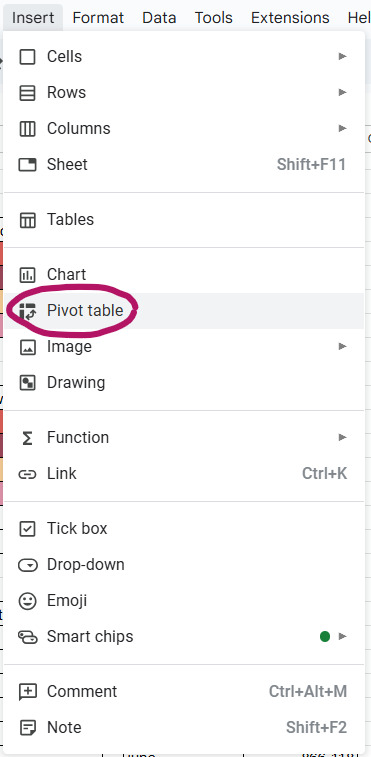
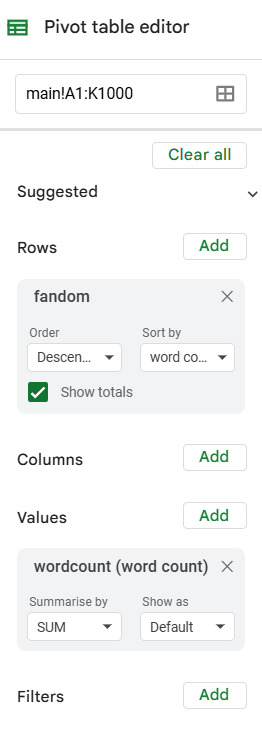
counting word count per month:
=SUM(main!H76:H121) I go in and change the parameters manually for every cell each month but there's probably an easier way of doing it
counting number of unique fics:
per month: =COUNTUNIQUEIFS(main!$A:$A, main!$N:$N, "Jan 2025")
per year: =COUNTA(UNIQUE(FILTER(main!$A:$A, YEAR(main!$G:$G) = 2025)))
I also have tables tracking my top ships, top tags, and top authors (these are all quite similar:
top ships: =QUERY(ARRAYFORMULA(FLATTEN(SPLIT(FLATTEN(main!D2:D1000),",;. ",1))), "SELECT Col1, COUNT(Col1) WHERE Col1 IS NOT NULL AND Col1 <> '#VALUE!' GROUP BY Col1 ORDER BY COUNT(Col1) DESC LIMIT 10 LABEL Col1 'ship'")
top tags: (I limit to the top 50) =QUERY(ARRAYFORMULA(FILTER(FLATTEN(TRIM(SPLIT(FLATTEN(main!F2:F1000), ","))), FLATTEN(TRIM(SPLIT(FLATTEN(main!F2:F1000), ","))) <> "")), "SELECT Col1, COUNT(Col1) WHERE Col1 IS NOT NULL GROUP BY Col1 ORDER BY COUNT(Col1) DESC LIMIT 50 LABEL Col1 'tag'")
top authors: =QUERY(ARRAYFORMULA(FLATTEN(SPLIT(FLATTEN(main!B2:B1000),",;. ",1))), "SELECT Col1, COUNT(Col1) WHERE Col1 IS NOT NULL AND Col1 <> '#VALUE!' GROUP BY Col1 ORDER BY COUNT(Col1) DESC LIMIT 10 LABEL Col1 'author'")
page 3: charts
using the tables from page 2, I generated these charts to help me visualise the data:

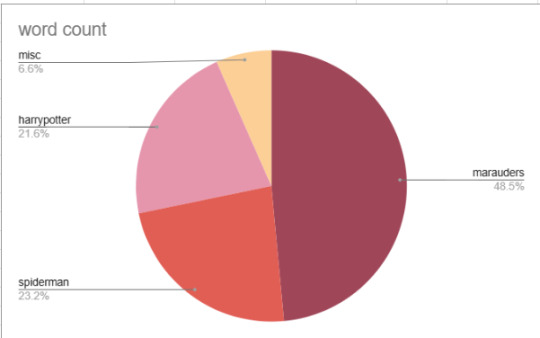
1 note
·
View note
Text
Mahalia - Different Type Of Love (feat. Masicka) [Official Visualiser]
youtube
MARCEDRIC KIRBY FOUNDER CEO. CFO. CFI.
MARCEDRIC.KIRBY INC.
WELCOME TO THE VALLEY OF THE VAMPIRES
I myself are working on a new Data Center Mall with the new technological in advance systems with business globally for a $1.2 million dollars buy in with top brand like Google Meta Amazon Microsoft Apple Walt Disney Six Flags Malls of American Alibaba weather and news stations with lots in more, membership discount cards are on the table limited time MARCEDRIC.KIRBY INC.
P.S. YOU CALL WE COMING TO YOUR CHURCH OR FAMILY YOU HAVE A RIDE TO THE MALL PART OF THE MEMBERSHIP
0 notes
Text
New Trends and Developments in AI Video Generation
The field of AI video generation is undergoing a revolutionary transformation, driven by groundbreaking advancements in generative AI. Cutting-edge models like OpenAI's Sora and Google's Veo can now produce high-fidelity, minute-long videos with remarkable coherence, realistic physics, and complex scene dynamics. The democratisation of this technology is accelerating through powerful open-source alternatives such as Stable Video Diffusion and AnimateDiff, enabling creators to generate and customise videos with unprecedented ease. Meanwhile, next-gen AI editing tools like Runway's Gen-3 and Adobe Firefly are redefining post-production with features like intelligent inpainting, style transfer, and automated enhancements.
The rise of real-time video synthesis and 3D-aware generation (exemplified by Luma AI's neural radiance fields) is unlocking new creative dimensions, while hyper-realistic AI avatars from platforms like Synthesia and HeyGen are transforming corporate communications and content creation. However, as capabilities grow, so do concerns about misuse, prompting significant developments in deepfake detection (Microsoft's VALL-E identifier) and content authentication (C2PA standards).
Looking ahead, AI video generation is poised to disrupt industries from filmmaking (automated storyboarding, VFX) to education (personalised learning content) and marketing (dynamic, data-driven ads). With multimodal AI systems integrating text, image, and video understanding, we're moving toward a future where interactive, AI-generated narratives become commonplace—blurring the lines between creator and audience while raising important questions about authenticity in the digital age.
Trends in AI Video Generation
High-Quality Long-Form Videos
The ability to generate extended, coherent video sequences represents one of the most significant leaps in AI video generation. Cutting-edge models like OpenAI's Sora and Google's Veo leverage advanced transformer architectures and diffusion models to produce videos lasting up to a minute or more while maintaining temporal consistency, realistic physics, and detailed scene composition. These systems can simulate complex interactions between objects and maintain proper lighting and shadows across frames, and even generate dynamic camera movements. This breakthrough is particularly valuable for industries like film pre-visualisation, advertising, and educational content creation, where longer-form, high-quality video generation was previously impossible without extensive manual effort.
Open-Source & Customizable Tools
The democratisation of AI video generation is being accelerated by powerful open-source alternatives like Stable Video Diffusion and AnimateDiff, which allow users to fine-tune models for specific use cases. These tools provide accessible frameworks for generating and modifying AI videos, enabling hobbyists, researchers, and small studios to experiment without relying on proprietary systems. Customisation options include adjusting motion patterns, applying stylistic filters, and even training models on niche datasets. This trend is fostering a vibrant ecosystem of community-driven innovations, plugins, and specialised applications that expand the creative possibilities of AI-generated video far beyond what closed systems can offer.
AI-Powered Editing
Modern AI video tools are revolutionising post-production workflows through features like Runway's Gen-3 and Adobe Firefly, which automate complex editing tasks. These platforms enable advanced inpainting (seamlessly removing or replacing objects), style transfer (applying artistic filters consistently across frames), and automatic enhancements (colour grading, stabilisation, and upscaling). Some tools even allow for text-based editing, where users can modify scenes through natural language prompts. This drastically reduces the time and technical expertise required for professional-grade video editing, making high-end production capabilities accessible to a broader range of creators.
Real-Time Generation
The push toward real-time AI video synthesis, led by companies like NVIDIA, is unlocking interactive applications that were previously unimaginable. By optimizing neural networks for low-latency inference, these systems can generate or modify video frames on the fly—enabling live streaming enhancements, instant video prototyping, and even AI-assisted broadcasting. Future applications could include real-time virtual backgrounds, instant video translation with lip-sync, and interactive storytelling where viewers influence the narrative as it unfolds.
3D & Dynamic Scenes
AI is bridging the gap between 2D and 3D content creation through technologies like Luma AI's neural radiance fields (NeRF), which can reconstruct 3D scenes from simple video clips. Other tools generate fully dynamic, volumetric videos that can be viewed from multiple angles, opening new possibilities for virtual production, augmented reality, and gaming. These advancements are particularly impactful for e-commerce (3D product showcases), virtual tourism, and cinematic effects, where depth-aware rendering adds realism and immersion.
Personalized AI Avatars
Platforms like Synthesia and HeyGen are making it possible to create lifelike digital presenters that can speak any language, mimic expressions, and even adapt their delivery based on context. These avatars are trained on minimal input data (sometimes just a short video clip), yet can generate natural-looking speech and gestures. Businesses use them for multilingual training videos, personalized marketing, and scalable customer service, while media companies experiment with AI news anchors and virtual influencers. As the technology improves, we may see hyper-personalized avatars that can replicate individual speaking styles for private or professional use.
Ethical Safeguards
As AI video generation becomes more convincing, the risk of misuse (e.g., deepfake scams, misinformation) has spurred parallel advancements in detection and authentication. Deepfake detectors (like Microsoft's VALL-E identifier) use AI to spot subtle artifacts in synthetic media, while initiatives like the Coalition for Content Provenance and Authenticity (C2PA) develop watermarking standards to label AI-generated content. Some platforms now embed invisible cryptographic signatures in media files, enabling verification of their origin. These measures aim to preserve trust in digital media while allowing legitimate creative uses of the technology to flourish.
New Developments in AI Video Generation
1. Text-to-Video Models with Longer Coherence
OpenAI's Sora : With its ability to create minute-long, high-fidelity videos with amazing coherence, realistic physics, and dynamic scenes, OpenAI's Sora represents a revolutionary advancement in AI video generation. Unlike earlier models limited to short, low-resolution clips, Sora leverages advanced diffusion models and transformer architectures to maintain temporal consistency, simulate complex interactions, and even generate dynamic camera movements—all from simple text prompts. Its ability to understand and render real-world physics, lighting, and object permanence makes it invaluable for applications in film pre-visualization, advertising, and virtual prototyping. While still in development, Sora showcases the rapid progress toward cinematic-quality AI-generated video, setting a new benchmark for the industry. However, OpenAI has implemented strict access controls to mitigate potential misuse, reflecting growing concerns around deepfake risks as the technology advances.
Google DeepMind's Veo: represents a cutting-edge advancement in AI video generation, pushing the boundaries of what's possible in synthetic media. As Google's answer to OpenAI's Sora, Veo leverages sophisticated deep learning architectures to produce high-definition, temporally coherent videos that can extend beyond a minute in length. The model demonstrates exceptional capabilities in maintaining object consistency, realistic motion physics, and nuanced scene transitions, even in complex multi-shot sequences. What sets Veo apart is its deep integration with Google's vast multimodal AI ecosystem, potentially allowing for enhanced contextual understanding and more natural scene compositions. The technology shows particular promise for professional content creators, offering granular control over visual styles and narrative elements through natural language prompts.Even though Veo is now only available to a select few, its creation shows Google's dedication to controlling the rapidly developing field of generative video, which might find use in everything from virtual world creation to filmmaking. Like its competitors, Veo's release has been accompanied by robust safety measures, including watermarking and content verification tools, addressing growing concerns about synthetic media's ethical implications. The model's ability to interpret and visualise abstract concepts suggests we're moving closer to AI systems that can serve as true creative collaborators in visual storytelling.
2. Open-Source & Customizable Tools
Stable Video Diffusion: represents a major open-source breakthrough in AI-powered video generation, democratising access to high-quality synthetic media creation. Developed by Stability AI, this innovative model builds upon the success of Stable Diffusion's image generation capabilities by introducing temporal consistency for video outputs. The system utilises a latent diffusion architecture specifically optimised for sequential frame generation, allowing users to transform text prompts or input images into short video clips with coherent motion. What makes Stable Video Diffusion particularly notable is its modular design, which enables fine-tuning for specialised applications ranging from animated avatars to product visualisations. Unlike proprietary alternatives, its open weights and adaptable framework have spawned a vibrant ecosystem of community-developed extensions, including tools for frame interpolation, style transfer, and motion control. The model currently produces clips of a few seconds in duration, with resolutions up to 1024x576, though ongoing optimisations continue to improve output quality and generation speed. While it may not yet match the cinematic fidelity of closed systems like Sora or Veo, Stable Video Diffusion's accessibility and customisability have made it invaluable for researchers, indie creators, and developers experimenting with next-gen media applications. Its release has significantly accelerated innovation in areas like AI-assisted animation, dynamic digital art, and rapid video prototyping while maintaining the ethical transparency characteristic of open-source AI initiatives.
AnimateDiff: has emerged as a groundbreaking open-source framework that breathes life into static images by transforming them into dynamic video sequences. Built as a plug-and-play motion module for Stable Diffusion models, this innovative technology allows users to animate any compatible text-to-image generation by adding realistic motion to previously still outputs. The system works by introducing temporal layers into the existing Stable Diffusion architecture, enabling coherent frame-to-frame transitions while preserving the original image's style and composition. What sets AnimateDiff apart is its remarkable flexibility - it can work with various community models and adapt to different artistic styles, from photorealistic scenes to anime-inspired artwork. The framework has become particularly valuable for content creators seeking to produce short animated clips, dynamic digital art, or prototype visual concepts without complex 3D animation software. While current outputs are typically limited to brief sequences of 16-24 frames, the open-source nature of AnimateDiff has fostered rapid community improvements, including extensions for longer animations, controlled camera movements, and enhanced motion consistency. This tool represents a significant step toward democratizing animation, making motion design accessible to a broader range of creators while maintaining the creative flexibility that has made Stable Diffusion so popular in the AI art community.
3.AI-Powered Editing
Runway Gen-3: represents a quantum leap in AI-powered video generation, pushing the boundaries of creative expression with its advanced neural architecture and unprecedented control over dynamic visuals. This cutting-edge model builds upon Runway's pioneering work in generative AI to deliver remarkably coherent, high-definition video sequences from simple text prompts or image inputs. What sets Gen-3 apart is its sophisticated temporal understanding, enabling smooth object movements, natural physics simulations, and cinematic transitions that maintain consistency across complex multi-shot sequences. The system introduces groundbreaking features like precision motion control, allowing creators to fine-tune the velocity and trajectory of elements within generated scenes through intuitive text commands. With enhanced capabilities for style transfer and multi-modal conditioning, Gen-3 can produce everything from photorealistic footage to stylized animations while preserving nuanced artistic signatures. Professional filmmakers and digital artists are leveraging its AI-assisted tools for rapid storyboarding, visual effects prototyping, and even final-shot generation, dramatically accelerating production workflows. The model's ability to interpret abstract creative concepts and translate them into visually compelling narratives positions it as more than just a tool—it's becoming a collaborative partner in the creative process. While maintaining robust ethical safeguards against misuse, Runway Gen-3 continues to redefine what's possible in AI-generated video, offering creators an expansive new palette for visual storytelling that blurs the line between imagination and reality.
Adobe Firefly: redefines creative workflows with its powerful AI-driven video and image generation capabilities, seamlessly integrated into the Adobe Creative Cloud ecosystem. As Adobe's flagship generative AI model, Firefly combines cutting-edge machine learning with professional-grade creative tools to deliver stunning visual outputs while prioritizing ethical AI practices through its commercially-safe training approach. The video-specific features empower creators to generate high-quality, editable footage from simple text prompts, with precise control over style, composition, and motion parameters. What truly distinguishes Firefly is its deep integration with industry-standard applications like Premiere Pro and After Effects, allowing for non-destructive AI-generated content that fits naturally into professional production pipelines. The system excels at intelligent video enhancements—automatically extending shots, generating background plates, or creating dynamic transitions while maintaining temporal consistency and visual fidelity. For motion graphics artists, Firefly's ability to interpret natural language into animated elements, kinetic typography, and stylized effects represents a paradigm shift in design efficiency. Adobe's focus on responsible innovation shines through features like Content Credentials, which embed transparent attribution data directly into generated assets. As Firefly continues evolving, it's not just automating tasks but augmenting human creativity—offering professionals an intelligent co-pilot that understands nuanced artistic intent while handling the technical complexities of modern digital content creation.
4.Real-Time Generation
It is revolutionizing the AI video landscape as industry leaders like NVIDIA pioneer technologies that enable instant video synthesis with unprecedented speed and efficiency. Leveraging the immense parallel processing power of next-generation GPUs and specialized neural accelerators, these cutting-edge systems can now generate or modify high-quality video frames in milliseconds—effectively eliminating the traditional latency associated with AI rendering. NVIDIA's breakthroughs in optimized inference engines and lightweight model architectures allow for seamless, on-the-fly video generation that keeps pace with live inputs, opening transformative possibilities for interactive applications. This real-time capability is powering innovations like instant video stylization for live streams, dynamic virtual backgrounds that adapt to movement, and AI-assisted broadcasting tools that can generate replays or highlight reels as events unfold. The technology also enables responsive creative workflows where directors can preview AI-generated scenes or effects immediately during production, dramatically accelerating iteration cycles. Beyond entertainment, real-time video synthesis shows promise for telepresence applications, where AI can reconstruct high-fidelity video from compressed data streams, and for augmented reality systems that require instantaneous environment rendering. As these systems continue to evolve with hardware-software co-design approaches, we're approaching a future where AI-generated video becomes as responsive and interactive as computer graphics are today—blurring the line between generation and reality in live video applications.
5.3D & Dynamic Scenes
AI now converts 2D videos into 3D (e.g., Luma AI) and generates immersive environments.
Luma AI: is revolutionizing 3D content creation with its cutting-edge neural rendering technology that transforms ordinary videos into stunning, photorealistic 3D models in seconds. Powered by advanced Neural Radiance Fields (NeRF) and Gaussian Splatting algorithms, Luma's AI effortlessly converts 2D smartphone footage into fully volumetric 3D scenes that preserve lighting, textures, and depth with remarkable accuracy. What sets Luma apart is its uncanny ability to capture intricate details and complex materials like glass, foliage, and reflective surfaces that traditionally challenged 3D scanning methods. The platform's intuitive interface democratizes professional-grade 3D modeling, allowing architects to digitize spaces, e-commerce brands to create interactive product displays, and filmmakers to generate virtual sets—all through simple video captures. Luma's real-time rendering capabilities enable smooth exploration of captured environments from any angle, while its AI-powered editing tools let users effortlessly modify lighting, remove objects, or adjust materials. As the technology evolves, Luma is bridging the gap between physical and digital worlds, making Hollywood-quality 3D assets accessible to creators everywhere and redefining possibilities for augmented reality, virtual production, and the metaverse.
6.Personalized AI Avatars
Synthesia: is transforming digital communication with its AI-powered video generation platform that creates ultra-realistic synthetic media in minutes. The platform's cutting-edge deep learning technology generates lifelike AI avatars that can speak in over 120 languages with perfectly synchronized lip movements and natural facial expressions, all from simple text input. What makes Synthesia revolutionary is its ability to produce professional-quality video content without cameras, microphones, or human presenters - businesses can create training materials, product demos, and personalized marketing videos at scale while maintaining brand consistency across global markets. The platform offers a diverse library of customizable digital presenters representing various ages, ethnicities, and professional appearances, complete with gesture controls and emotional tone adjustments. Synthesia's studio-quality outputs eliminate traditional video production barriers, enabling enterprises to update content instantly, localize messages without reshoots, and maintain an always-on video presence. With robust ethical safeguards and watermarking technology, Synthesia is leading the responsible adoption of synthetic media while redefining how organizations communicate in the digital age - making high-quality video content as easy to produce as writing an email.
HeyGen is revolutionizing digital storytelling with its AI-powered video creation platform that turns simple scripts into professional-quality videos featuring hyper-realistic virtual presenters. Leveraging cutting-edge generative AI, the platform instantly animates custom avatars that deliver lifelike performances complete with natural facial expressions, gestures, and perfectly synchronized voiceovers in multiple languages. What sets HeyGen apart is its seamless blend of intuitive design with advanced capabilities—users can create studio-grade videos simply by typing text, selecting from a diverse library of AI talents, or uploading their own digital clone through a short video sample. The platform excels at producing engaging explainer videos, personalized sales pitches, and dynamic training content without the need for expensive production crews or equipment. With features like automatic lip-sync for 140+ languages, emotion control, and customizable backgrounds, HeyGen empowers businesses to scale their video output while maintaining brand consistency across global markets. Its responsible AI framework incorporates visible watermarking and usage guidelines, positioning HeyGen as an ethical leader in the synthetic media space. By making broadcast-quality video accessible to anyone with an idea, HeyGen is transforming how companies communicate. market, and train in the digital age—turning every team member into a compelling video creator overnight.
Ethical Safeguards
C2PA (Coalition for Content Provenance and Authenticity) represents a groundbreaking initiative in the fight against digital misinformation by establishing an open technical standard for content authentication. Developed through collaboration between tech giants, media organisations, and camera manufacturers, this innovative framework embeds tamper-evident metadata directly into digital files like a "nutrition label" for media. Using cryptographic signatures and blockchain-like technology, C2PA creates an unbroken chain of custody from content creation through editing, enabling anyone to verify a file's origin and modification history. The system works across photos, videos, and audio files, allowing platforms and users to distinguish between authentic human-created content, AI-generated material, and manipulated media with unprecedented reliability. Major implementations by Adobe, Microsoft, and camera manufacturers are bringing this transparency to professional workflows, while social platforms explore using C2PA markers to flag synthetic content. As AI-generated media becomes indistinguishable from reality, C2PA's content credentials are emerging as critical infrastructure for maintaining trust in digital information—giving creators a way to claim ownership, journalists a method to verify sources, and audiences the tools to make informed judgements about what they see online. The standard continues evolving to address new challenges in the synthetic media landscape while balancing transparency with privacy concerns, positioning itself as the universal language of digital content authenticity in the AI age.
Conclusion
The rapid evolution of AI video generation is ushering in a transformative era for digital content creation, marked by unprecedented capabilities and accessibility. These developments are making it harder to distinguish between virtual and physical media, from real-time production and 3D scene conversion to high-quality, long-form video synthesis using models like Sora and Veo. Open-source tools like Stable Video Diffusion and AnimateDiff are democratising creativity, while AI-powered editing platforms such as Runway Gen-3 and Adobe Firefly are streamlining professional workflows. Strong ethical protections like C2PA are guaranteeing responsible adoption, while Synthesia and HeyGen's incredibly lifelike AI avatars are revolutionising personalised communication. Together, these innovations are not just enhancing how we produce video content—they're reimagining storytelling, marketing, education, and entertainment in the age of AI. As the technology continues to mature, the focus will remain on balancing groundbreaking creativity with ethical integrity, shaping a future where AI and human collaboration unlock limitless possibilities for visual expression.
0 notes
Text
Smart havevanding: De bedste apps og gadgets i 2025 Havearbejde har altid været en kombination af passion og præcision. Men i 2025 er det ikke længere nødvendigt at stole på gammeldags haveslanger og manuelle rutiner. Smart havevanding har revolutioneret måden, vi plejer vores haver på – med teknologiske løsninger, der er både effektive, bæredygtige og tidsbesparende. I denne artikel dykker vi ned i de bedste apps og gadgets til smart havevanding i 2025, og hvordan du kan tage din havepleje til det næste niveau.
Hvorfor vælge smart havevanding?
Smart havevanding er ikke kun for teknikentusiaster – det er en investering i din have og din tid. Her er nogle af fordelene:
💧 Reduceret vandforbrug Smarte systemer måler jordens fugtighed og tilpasser vandingen, så du undgår spild.
⏱ Automatisering af vandingsrutiner Med automatiske tidsindstillinger og vejrdata undgår du at skulle huske at vande – selv når du er på ferie.
📱 Fjernstyring via app Styr hele dit vandingssystem fra din smartphone, tablet eller stemmestyret assistent som Alexa eller Google Assistant.
🌿 Sundere planter Mere præcis vanding giver bedre vækstbetingelser og færre syge planter.
Top 5 smarte havevanding-gadgets i 2025
1. Gardena Smart System 2025 Edition
Gardena har været en pioner inden for havevanding, og deres 2025-model er mere avanceret end nogensinde. Den indeholder:
Smart sensor, der måler jordens fugtniveau i realtid
Automatisk tilpasning til vejrforhold via online data
Mulighed for integration med robotplæneklipper og smart belysning
Fordel: Komplett økosystem, ideelt til større haver. Pris: Ca. 3.200 kr.
2. Eve Aqua – Trådløs vandingskontrol
Eve Aqua er populær for sin elegante integration med Apple HomeKit og iOS.
Styring via Siri og Apple Home-appen
Bluetooth-baseret, ingen ekstra hub nødvendig
Perfekt til mindre haver og terrasser
Fordel: Enkel opsætning og flot design. Pris: Ca. 850 kr.
3. Rachio 3 Smart Sprinkler Controller
En favorit i USA, som også vinder frem i Europa i 2025.
Styrer op til 16 separate zoner
Avancerede algoritmer med vejrprognoser
App-styring og stemmeassistent-integration (Alexa, Google)
Fordel: Perfekt til dem med større græsplæner eller mange sektioner. Pris: Ca. 2.200 kr.
4. Orbit B-hyve Smart Hose Faucet Timer
Genial til dem, der bruger almindelig haveslange.
Tilsluttes direkte til vandhanen
App-styring og fugtighedssensor
Budgetvenlig løsning
Fordel: Billig og nem opgradering til en "dum" vandhane. Pris: Ca. 500 kr.
5. Xiaomi Mi Smart Garden Kit
Xiaomi gør det let at komme i gang med smart vanding, især til krukker og småhaver.
Sensorer, der registrerer temperatur, lys og fugt
Automatisk drypvanding
Kompakt og minimalistisk
Fordel: God løsning til altaner og mindre køkkenhaver. Pris: Ca. 950 kr.
De bedste apps til smart havevanding
🌐 1. MyGarden (Gardena App)
Gardena’s egen app tilbyder detaljeret kontrol og visualisering af dit haveområde.
Skræddersyet vandingsplan
Advarsler ved tørke eller frost
Brugervenlig grænseflade
🌐 2. Rachio App
Kendt for sin intuitive brugerflade og præcise vejrdata.
Dynamisk tilpasning til klima og sæson
Avanceret statistik og vandforbrug
“Skip watering” funktion ved regnvejr
🌐 3. Home Assistant + Eve Aqua
Eve Aqua og HomeKit kan kombineres med Home Assistant for avancerede automationsflows.
Integration med sensorer og stemmestyring
Flow-triggers baseret på tid, vejr og placering
Lokal kontrol uden cloud-behov
🌐 4. B-hyve App (Orbit)
Simpel og funktionel app til både begyndere og erfarne brugere.
Manuel og automatisk vandingsplan
Forbind flere vandhaner
Nem overvågning af zoner
Sådan kommer du i gang
Kortlæg din have – Hvor mange zoner skal vandes? Har du krukker, græsplæne eller højbede?
Vælg det rigtige system – Vælg en løsning baseret på dit behov og din tekniske komfort.
Installer og forbind – Følg producentens vejledning og test systemet.
Opsæt automatiske rutiner – Brug appen til at indstille ugeskema, sensorer og vejrintegration.
Overvåg og tilpas løbende – Brug appens data til at optimere vandforbrug og justere ved ændringer i vejr.
Bæredygtighed og fremtiden for havevanding
I takt med klimaændringer og vandmangel i flere dele af verden, bliver smart havevanding ikke bare en luksus – men en nødvendighed. Mange apps og gadgets i 2025 fokuserer nu på:
Integrering med regnvandsopsamling
AI-drevet analyse af plantebehov
Solcelledrevne pumper og sensorer
Teknologien gør det muligt at skabe grønne oaser – med minimal miljøpåvirkning.
Konklusion
Smart havevanding i 2025 handler om at kombinere teknologi med natur. Med de rette apps og gadgets kan du spare tid, reducere vandforbruget og skabe en sundere have uden stress. Uanset om du har en lille altan eller en stor villahave, findes der en løsning, der passer til dine behov.
Gør din have smartere – og grønnere – med intelligent havevanding.
0 notes